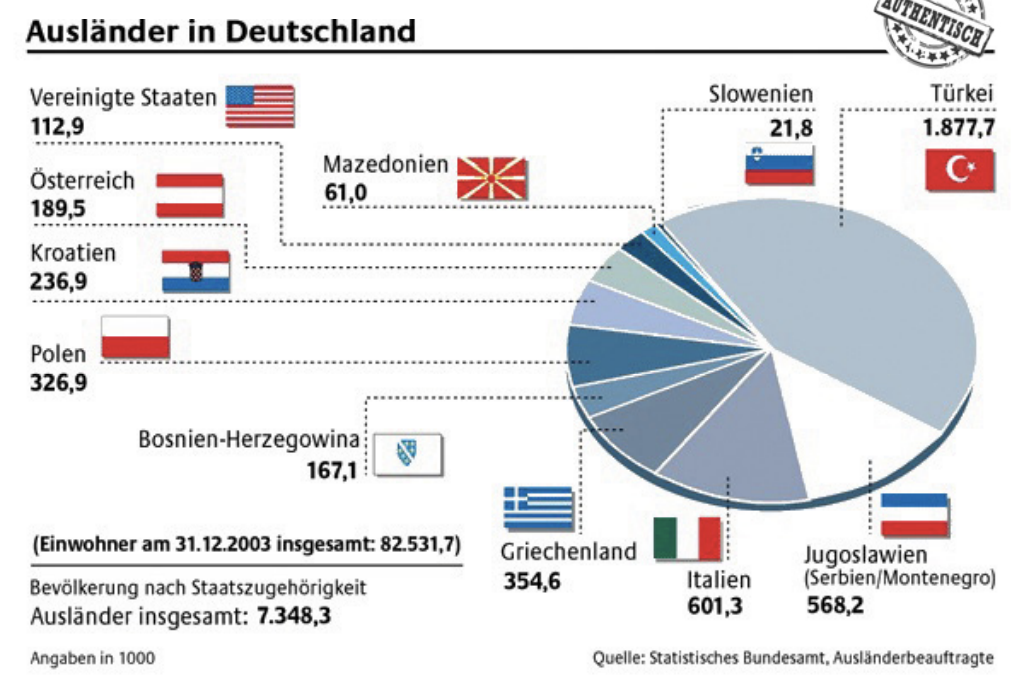1.3: Die Zahlen
- Page ID
- 103653
Aktivität 5. Wie lautet deine Telefonnumber?
Die Zahlen

Please note that the German numbers can be confusing, especially the handwritten numbers 1 and 7. And you do not want to miss that all-important date because a German 1 can look like an American 7.
A. Ask two of your classmates what their phone numbers are:
Wie lautet deine Telefonnummer?
Meine Telefonnummer ist: ________________________________________________
B. Now report back to your instructor: Seine/Ihre Telefonnummer ist…
Aktivität 6. Wichtige Adressen & Telefonnumern in Deutschland
When you go to German-speaking countries, you will likely need to call someone at some point (e.g., your school, a pizzeria, etc.). Contact information is often presented differently in various cultures, so it helps to familiarize yourself with how to glean phone numbers, addresses, opening times abroad. As a first step, read the following information and answer the questions below.

1. What are the address and the telephone number of the American Embassy? When is its office for citizenship services open? Which days and what time? What is the phone number and what is the fax number?
2. What is the address of the Uni Würzburg’s international student office? Where could you get more information about the office?
3. What is the address of the pizza delivery service? What is the zip code? What is the phone number?
4. What do you think Notrufnummern means? What does Feuer mean and who do you call with the number 112?
Aktivität 7. Zahlen and Nummern
Although you can list the individual digits of your phone number (and many Germans do), a lot of people use double or triple digits like in English, or as you would state your age.
So, your friend’s phone number can be 0-1-7-5-6-1-8-0-6-7-0
null-eins-sieben-fünf-sechs-eins-acht-null-sechs-sieben-null
or 0-1-7-5-61-80-670
null-eins-sieben-fünf-einundsechzig-achtzig-sechshundertsiebzig
Similarly, your age is not 1-9 (eins neun) but rather 19 (neunzehn).

Aktivität 8. Das Alter
Ask the two classmates you’ve been working with how old they are.
S1: Wie alt bist du?
S2: Ich bin ____________________________________ Jahre alt.
S2: Und du? Wie alt bist du?
S1: Ich bin ____________________________________ Jahre alt.
When you report back to your instructor, use
Er/sie ist ______________________________________ Jahre alt.

Aktivität 9. Wie viel kostet es?
You use double and triple digits for expressing how much something costs as well. Look at the following Rechnung and identify how much we paid for the Pizza Margherita, the „Quo Vadis” house salad, the coke, the Pellegrino mineral water, and the espresso. Write the prices out with words.

Aktivität 10. Sprache im Kontext: Mit dem Bus zur Uni
Knowing your numbers comes in very handy when you want to travel by bus, too.
A. Watch the Sprache im Kontext clip with Tobias, and write down what the clip is about:
What do you notice? Who is in the clip? Where does it take place? etc.
B. Watch the clip again and check all words that you hear.
Busticket
Universität
Bargeld
Studenten
Studentenausweis
bezahlen
kosten
fahren
Fahrplan
C. Watch the clip again and answer the questions below
1. Which three buses go in die Stadt and to the Hubland?
1 10 14 40 114 1400
2. What do you need to get to the Hubland campus by bus?
1. A bus pass, which you can buy on any bus or tram in Würzburg
2. Cash (Bargeld); at least 10 Euro
3. Your student ID card, which lets you travel free on any public transportation in Würzburg
D. Listen to the clip one more time. What article does Tobias use in front of the key nouns in his message? What does the article indicate about the gender of these nouns?
_____________ Tobias
_____________ Hubland (Campus)
_____________ Bushaltestelle
_____________ Nummer
_____________ Linie
_____________ Studentenausweis
Aktivität 11. Wurzburg entdecken
You just arrived in Würzburg and even though it is not the biggest city as you will see in the next exercise it is different than what you are used to in the US. Answer the questions on the next page using the map below.

1. Wie lautet die Adresse des Studentenwerks? (Write out the numbers of the zip code.)
2. Wie lautet die Telefonnummer der Jugendherberge in Würzburg?
3. In welcher Straße liegt die Universität in Würzburg und welche Hausnummer hat sie?
4. Deine Wohnung liegt „Am Kugelfang”. Welchen Bus/welche Busse musst du zur Uni nehmen?
Aktivität 12. Und wer wohnt in Würzburg?
Here are statistical information about the city of Würzburg from their website. Practice your Zahlen and try to match the nouns on the right hand side with the corresponding German terms in the table. You may use a dictionary. Then check with your classmates and the teacher.

Aktivität 13. Würzburg versus Deutschland
In the following you will engage with more statistical data about Würzburg and Germany. The Bundesinstitut für Bevölkerungsforschung (federal institute for population research) offers a variety of tables, maps, graphs and other visualized statistics along with explanations. Visit any of the following websites for more facts about Germany: http://www.bib-demografie.de, http://www.tatsachen-ueber-deutschand.de or http://www.auswaertiges-amt.de.
A. Compare and discuss the information about Würzburg and Germany
| Infobox | Würzburg | Deutschland |
| Einwohner | 135.212 | 82.002.400 |
| Ausländeranteil | 12,8% | 8,8% |
| Bevölkerung mit Migrationshintergrund | Keine Angaben | 19,3% |
| Arbeitslosenquote | 5% | 7% |
| Bruttoeinkommen | 26.319€ | 27.493€ |
| Sozialhilfeempfänger | 2,6% | 3,5% |
| Kita-Quote | 55,25% | 50,25% |
1. What does Bevölkerung mit Migrationshintergrund mean? How is it different to Ausländeranteil?
2. What is a Kita-Quote? Do you have that in your city or country?
3. Which information surprise/confuse/shock you?
B. What does the following statistic tell you?

1. Wie heißen die Nationen auf Englisch? Welche Nation ist am meisten vertreten (most represented)? Warum?
2. Wie heißen die Personen aus den Ländern? Complete below and pick two more
| die Türkei | Österreich | Italien | ||
| der Türke die Türkin |
der Österreicher die |
der |


